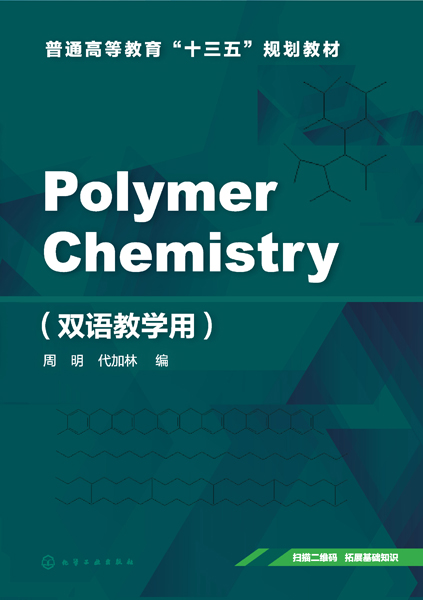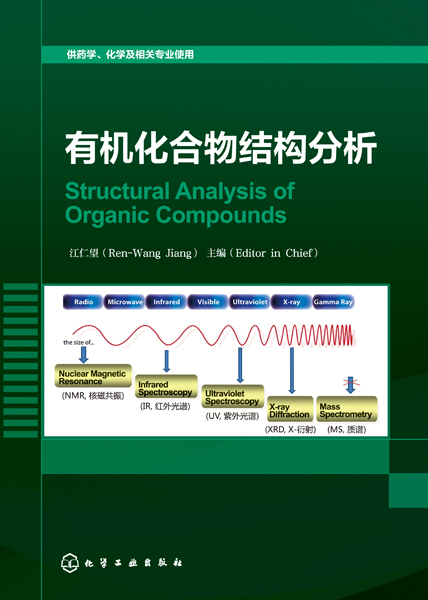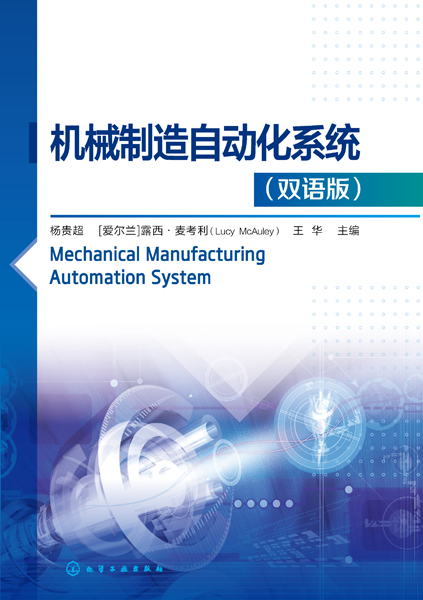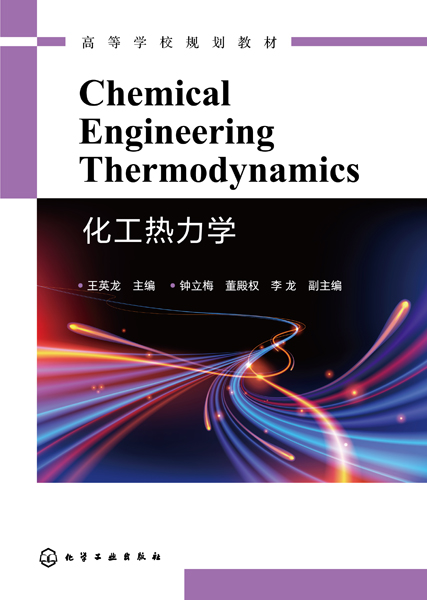高分子材料导论(双语教学用)
定价:¥49.00
作者: 李坚
出版时间:2014-03
出版社:化学工业出版社
- 化学工业出版社
- 9787122192172
- 1版
- 105133
- 49220951-5
- 16开
- 2014-03
- 419
- 262
- ①TB324
- 材料类
- 本科
作者简介
内容简介
本书是为高分子及其相关专业的学生编写的双语教学用教材。全书共分10章,依次介绍了聚合物合成,聚合物的结构、分子运动及转变,聚合物固体性能,聚合物的测试与表征,塑料,弹性体,聚合物复合材料,涂料以及聚合物科学与技术进展。教材覆盖面广、内容丰富,既包含了高分子专业的基础知识,如高分子化学、高分子物理等方面的内容;又介绍了一些基本的高分子材料品种,如聚乙烯、聚丙烯、聚苯乙烯及弹性体等;还对高分子材料在涂料方面的应用作了介绍。每章编写有相应的习题供复习使用。希望本教材能起到在学习英语的同时,既能复习巩固专业基础知识,又能拓宽相应专业知识的作用,为今后的学习与研究打下良好的基础。
本书可供高分子材料、材料化学、精细化工及应用化学以及相关专业的高年级学生学习使用,也适合相关专业的研究生参考学习。
本书可供高分子材料、材料化学、精细化工及应用化学以及相关专业的高年级学生学习使用,也适合相关专业的研究生参考学习。
目录
Chapter 1 Introduction 1
1.1 Classification of polymerizations 1
1.1.1 Condensation and addition polymerization 1
1.1.2 Step and chain polymerizations 3
1.2 Classification of Polymers 5
1.2.1 Classification by source 5
1.2.2 Classification by mechanical behavior and application 5
1.2.3 Classification by synthesis reaction 6
1.2.4 Classification by chain structure 6
1.2.5 Classification by processing characteristics 7
1.3 Physical State, Property and Application of Polymers 8
1.3.1 Crystalline and amorphous behavior 8
1.3.2 Thermal transitions 8
1.3.3 General properties of polymers 9
1.3.4 Applications of polymer materials 10
1.4 Polymer Processing 10
1.4.1 Ingredients of polymer materials 11
1.4.2 Processing methods 11
1.5 Development of Polymer Science and Engineering 13
1.5.1 Brief history of polymer materials 13
1.5.2 Establishment of polymer science 14
1.5.3 The development of synthetic polymers 14
Problems 19
Chapter 2 Polymer Synthesis 20
2.1 Step Polymerization 20
2.1.1 Basis for analysis of polymerization kinetics 21
2.1.2 Kinetics of step polymerization 22
2.1.3 Molecular weight control in linear polymerization 28
2.2 Radical Chain Polymerization 33
2.2.1 Rate of radical chain polymerization 33
2.2.2 Molecular weight 38
2.2.3 Chain transfer 40
2.2.4 Inhibition and retardation 42
2.2.5 Process conditions 43
Problems 47
Chapter 3 Polymer Structure, Molecular Motions and Transitions of Polymers 50
3.1 General Introduction for Polymer Structures 50
3.1.1 Structural groups 50
3.1.2 Linear chain polymers 51
3.1.3 Configurations of polymer chains 53
3.1.4 Conformation 55
3.1.5 Copolymers 55
3.1.6 Network polymers 56
3.2 Characteristics of Macromolecular Motions and Transitions 56
3.2.1 The Glassy Region 57
3.2.2 The Glass Transition Region 57
3.2.3 The Rubbery Plateau Region 58
3.2.4 The Rubbery Flow Region 59
3.2.5 The Liquid Flow Region 59
3.3 Molecular Motion and Thermal Transitions 59
3.3.1 Theories of glass transition 60
3.3.2 Factors affecting glass transition temperature 62
3.3.3 The crystalline melting point 69
3.3.4 Factors affecting the crystalline melting point, Tm 70
Problems 74
Chapter 4 Solid State Properties of Polymers 76
4.1 Mechanical Properties 76
4.1.1 Forces Versus Deformation Properties 77
4.1.2 Toughness 83
4.1.3 Creep 87
4.2 Optical Properties 88
4.2.1 Haze 88
4.2.2 Transparency 89
4.2.3 Gloss 90
4.3 Surface Contact Properties 90
4.3.1 Friction 90
4.3.2 Cling 92
4.3.3 Wear Resistance 92
4.4 Barrier Properties 93
4.4.1 Permeation through Polymers 94
4.4.2 Barrier Property Analysis 95
4.5 Electrical Properties 96
4.5.1 Electrical Resistance 96
4.5.2 Capacitive Properties 97
4.5.3 Dielectric Strength 98
4.5.4 Arc Resistance 99
4.5.5 Corona Treatment 99
4.5.6 Factors Influencing Polymers in Electrical Applications 99
4.6 Weather Resistance 100
4.6.1 Natural Outdoor Weathering 100
4.6.2 Accelerated Outdoor Weathering 101
4.6.3 Artificial Weathering 101
Problems 101
Chapter 5 Characterization and Testing of Polymers 103
5.1 Gel Permeation Chromatography 103
5.1.1 GPC Instrumentation 103
5.1.2 Calibration 105
5.1.3 Selection and Assembly of Detectors 106
5.2 Infrared Spectroscopy 106
5.2.1 Instrument and Experimental Method 107
5.2.2 Applications to Polymers 108
5.3 X-ray Diffraction Analysis 110
5.3.1 Experimental Methods 110
5.3.2 Application to Polymers 111
5.4 Nuclear Magnetic Spectroscopy 112
5.4.1 Experimental Methods 112
5.4.2 Application to Polymers 113
5.5 Thermal Analysis 118
5.5.1 Thermogravity Analysis (TGA) 118
5.5.2 Differential Scanning Calorimetry (DSC) 119
5.6 Light and Electron Microscopy 122
5.6.1 Light Microscopy 122
5.6.2 Electron Microscopy 123
Problems 126
Chapter 6 Plastics 128
6.1 Polyethylene 128
6.1.1 Low Density Polyethylene (LDPE) 130
6.1.2 High density polyethylene (HDPE) 134
6.1.3 Linear low density polyethylene (LLDPE) 135
6.1.4 Ethylene-vinyl acetate copolymer (EVA) 136
6.1.5 Crosslinked polyethylene (XPE) 137
6.2 Polypropylene (PP) 137
6.2.1 Isotactic polypropylene 138
6.2.2 Syndiotactic polypropylene (sPP) 139
6.3 Polyvinyl Chloride (PVC) 140
6.3.1 Polymerization 140
6.3.2 Structure and Properties 141
6.3.3 Copolymers 142
6.3.4 Application 142
6.4 Polystyrene (PS) and Related Polymers 143
6.4.1 Polymerization of styrene 143
6.4.2 Structure and properties 143
6.4.3 Copolymers of styrene 144
6.4.4 Syndiotactic polystyrene (sPS) 145
6.4.5 Application 145
6.5 Polymethyl Methacrylate (PMMA) 146
6.5.1 Polymerization 146
6.5.2 Structure and property 146
6.5.3 Application 147
6.6 Polyamide (Nylon) 147
6.6.1 Polyhexamethylene adipamide (nylon-66) 147
6.6.2 Other important polyamides 149
6.7 Polyethylene terephthalate (PET) 150
6.7.1 Polymerization 150
6.7.2 Property and application 150
6.8 Polyoxymethylene (POM) 151
6.8.1 Polymerization 151
6.8.2 Property 152
6.8.3 Application 152
6.9 Polycarbonate (PC) 152
6.10 Polytetrafluoroethylene (PTFE) 152
6.10.1 Polymerization 153
6.10.2 Structure 153
6.10.3 Property 154
6.10.4 Effect of structure on property 154
6.10.5 Fabrication and processing 154
6.10.6 Application 156
6.10.7 Fluorocarbon copolymers 156
Problems 156
Chapter 7 Elastomers 158
7.1 Basics for Elastomers 158
7.2 Morphology of Thermoplastic Elastomers 162
7.2.1 General characteristics 162
7.2.2 Properties and effect of structure 163
7.2.3 Mechanical properties 165
7.2.4 Thermal and chemical properties 168
7.3 Diene Elastomers 169
7.3.1 Butadiene-based elastomers 169
7.3.2 Polyisoprene 170
7.3.3 Polychloroprene 170
7.3.4 Styrene -butadiene rubber (SBR) 170
7.3.5 Metathesis elastomers 173
7.3.6 Nondiene elastomers 174
7.3.7 Thermoplastic elastomers 176
Problems 178
Chapter 8 Polymer Composites 179
8.1 Introduction to Composites 179
8.2 A Brief History of Polymer Composites 180
8.3 General Use Considerations 182
8.4 Technology Overview 184
8.4.1 Reinforcements 184
8.4.2 Matrices 186
8.4.3 Coupling agents 189
8.4.4 PMC forms 189
8.4.5 Fabrication processes 190
8.5 Applications of Polymer Composites 192
8.6 Nanocomposites 193
8.7 View of the Future 194
Problems 195
Chapter 9 Paint and Coatings 197
9.1 Principles of Coating 197
9.1.1 Rheology 198
9.1.2 Viscosity behavior 199
9.1.3 Surface chemistry 201
9.2 Composition of Paint 209
9.2.1 Introduction 209
9.2.2 Binder 209
9.2.3 Pigments 210
9.2.4 Solvents 211
9.2.5 Additives 212
9.2.6 Fillers (Extenders) 213
9.3 Theory of Adhesion 213
9.3.1 Introduction 213
9.3.2 Mechanical bonding 213
9.3.3 Electrostatic attraction 214
9.3.4 Chemical bonding 215
9.3.5 Paint diffusion 215
9.4 Coating Materials 216
9.4.1 Acrylics 218
9.4.2 Alkyd resins 218
9.4.3 Epoxies 220
9.4.4 Polyurethanes 221
Problems 223
Chapter 10 Developments in Polymer Science and Technology 224
10.1 Synthesis Technology 224
10.1.1 Living radical polymerization 224
10.1.2 Living cationic polymerization 235
10.2 New Polymer Materials and Applications 239
10.2.1 Dendritic (highly branched) polymers 239
10.2.2 Conducting Polymers 243
10.2.3 Bio-degradable polymers 254
Problems 260
References 262
1.1 Classification of polymerizations 1
1.1.1 Condensation and addition polymerization 1
1.1.2 Step and chain polymerizations 3
1.2 Classification of Polymers 5
1.2.1 Classification by source 5
1.2.2 Classification by mechanical behavior and application 5
1.2.3 Classification by synthesis reaction 6
1.2.4 Classification by chain structure 6
1.2.5 Classification by processing characteristics 7
1.3 Physical State, Property and Application of Polymers 8
1.3.1 Crystalline and amorphous behavior 8
1.3.2 Thermal transitions 8
1.3.3 General properties of polymers 9
1.3.4 Applications of polymer materials 10
1.4 Polymer Processing 10
1.4.1 Ingredients of polymer materials 11
1.4.2 Processing methods 11
1.5 Development of Polymer Science and Engineering 13
1.5.1 Brief history of polymer materials 13
1.5.2 Establishment of polymer science 14
1.5.3 The development of synthetic polymers 14
Problems 19
Chapter 2 Polymer Synthesis 20
2.1 Step Polymerization 20
2.1.1 Basis for analysis of polymerization kinetics 21
2.1.2 Kinetics of step polymerization 22
2.1.3 Molecular weight control in linear polymerization 28
2.2 Radical Chain Polymerization 33
2.2.1 Rate of radical chain polymerization 33
2.2.2 Molecular weight 38
2.2.3 Chain transfer 40
2.2.4 Inhibition and retardation 42
2.2.5 Process conditions 43
Problems 47
Chapter 3 Polymer Structure, Molecular Motions and Transitions of Polymers 50
3.1 General Introduction for Polymer Structures 50
3.1.1 Structural groups 50
3.1.2 Linear chain polymers 51
3.1.3 Configurations of polymer chains 53
3.1.4 Conformation 55
3.1.5 Copolymers 55
3.1.6 Network polymers 56
3.2 Characteristics of Macromolecular Motions and Transitions 56
3.2.1 The Glassy Region 57
3.2.2 The Glass Transition Region 57
3.2.3 The Rubbery Plateau Region 58
3.2.4 The Rubbery Flow Region 59
3.2.5 The Liquid Flow Region 59
3.3 Molecular Motion and Thermal Transitions 59
3.3.1 Theories of glass transition 60
3.3.2 Factors affecting glass transition temperature 62
3.3.3 The crystalline melting point 69
3.3.4 Factors affecting the crystalline melting point, Tm 70
Problems 74
Chapter 4 Solid State Properties of Polymers 76
4.1 Mechanical Properties 76
4.1.1 Forces Versus Deformation Properties 77
4.1.2 Toughness 83
4.1.3 Creep 87
4.2 Optical Properties 88
4.2.1 Haze 88
4.2.2 Transparency 89
4.2.3 Gloss 90
4.3 Surface Contact Properties 90
4.3.1 Friction 90
4.3.2 Cling 92
4.3.3 Wear Resistance 92
4.4 Barrier Properties 93
4.4.1 Permeation through Polymers 94
4.4.2 Barrier Property Analysis 95
4.5 Electrical Properties 96
4.5.1 Electrical Resistance 96
4.5.2 Capacitive Properties 97
4.5.3 Dielectric Strength 98
4.5.4 Arc Resistance 99
4.5.5 Corona Treatment 99
4.5.6 Factors Influencing Polymers in Electrical Applications 99
4.6 Weather Resistance 100
4.6.1 Natural Outdoor Weathering 100
4.6.2 Accelerated Outdoor Weathering 101
4.6.3 Artificial Weathering 101
Problems 101
Chapter 5 Characterization and Testing of Polymers 103
5.1 Gel Permeation Chromatography 103
5.1.1 GPC Instrumentation 103
5.1.2 Calibration 105
5.1.3 Selection and Assembly of Detectors 106
5.2 Infrared Spectroscopy 106
5.2.1 Instrument and Experimental Method 107
5.2.2 Applications to Polymers 108
5.3 X-ray Diffraction Analysis 110
5.3.1 Experimental Methods 110
5.3.2 Application to Polymers 111
5.4 Nuclear Magnetic Spectroscopy 112
5.4.1 Experimental Methods 112
5.4.2 Application to Polymers 113
5.5 Thermal Analysis 118
5.5.1 Thermogravity Analysis (TGA) 118
5.5.2 Differential Scanning Calorimetry (DSC) 119
5.6 Light and Electron Microscopy 122
5.6.1 Light Microscopy 122
5.6.2 Electron Microscopy 123
Problems 126
Chapter 6 Plastics 128
6.1 Polyethylene 128
6.1.1 Low Density Polyethylene (LDPE) 130
6.1.2 High density polyethylene (HDPE) 134
6.1.3 Linear low density polyethylene (LLDPE) 135
6.1.4 Ethylene-vinyl acetate copolymer (EVA) 136
6.1.5 Crosslinked polyethylene (XPE) 137
6.2 Polypropylene (PP) 137
6.2.1 Isotactic polypropylene 138
6.2.2 Syndiotactic polypropylene (sPP) 139
6.3 Polyvinyl Chloride (PVC) 140
6.3.1 Polymerization 140
6.3.2 Structure and Properties 141
6.3.3 Copolymers 142
6.3.4 Application 142
6.4 Polystyrene (PS) and Related Polymers 143
6.4.1 Polymerization of styrene 143
6.4.2 Structure and properties 143
6.4.3 Copolymers of styrene 144
6.4.4 Syndiotactic polystyrene (sPS) 145
6.4.5 Application 145
6.5 Polymethyl Methacrylate (PMMA) 146
6.5.1 Polymerization 146
6.5.2 Structure and property 146
6.5.3 Application 147
6.6 Polyamide (Nylon) 147
6.6.1 Polyhexamethylene adipamide (nylon-66) 147
6.6.2 Other important polyamides 149
6.7 Polyethylene terephthalate (PET) 150
6.7.1 Polymerization 150
6.7.2 Property and application 150
6.8 Polyoxymethylene (POM) 151
6.8.1 Polymerization 151
6.8.2 Property 152
6.8.3 Application 152
6.9 Polycarbonate (PC) 152
6.10 Polytetrafluoroethylene (PTFE) 152
6.10.1 Polymerization 153
6.10.2 Structure 153
6.10.3 Property 154
6.10.4 Effect of structure on property 154
6.10.5 Fabrication and processing 154
6.10.6 Application 156
6.10.7 Fluorocarbon copolymers 156
Problems 156
Chapter 7 Elastomers 158
7.1 Basics for Elastomers 158
7.2 Morphology of Thermoplastic Elastomers 162
7.2.1 General characteristics 162
7.2.2 Properties and effect of structure 163
7.2.3 Mechanical properties 165
7.2.4 Thermal and chemical properties 168
7.3 Diene Elastomers 169
7.3.1 Butadiene-based elastomers 169
7.3.2 Polyisoprene 170
7.3.3 Polychloroprene 170
7.3.4 Styrene -butadiene rubber (SBR) 170
7.3.5 Metathesis elastomers 173
7.3.6 Nondiene elastomers 174
7.3.7 Thermoplastic elastomers 176
Problems 178
Chapter 8 Polymer Composites 179
8.1 Introduction to Composites 179
8.2 A Brief History of Polymer Composites 180
8.3 General Use Considerations 182
8.4 Technology Overview 184
8.4.1 Reinforcements 184
8.4.2 Matrices 186
8.4.3 Coupling agents 189
8.4.4 PMC forms 189
8.4.5 Fabrication processes 190
8.5 Applications of Polymer Composites 192
8.6 Nanocomposites 193
8.7 View of the Future 194
Problems 195
Chapter 9 Paint and Coatings 197
9.1 Principles of Coating 197
9.1.1 Rheology 198
9.1.2 Viscosity behavior 199
9.1.3 Surface chemistry 201
9.2 Composition of Paint 209
9.2.1 Introduction 209
9.2.2 Binder 209
9.2.3 Pigments 210
9.2.4 Solvents 211
9.2.5 Additives 212
9.2.6 Fillers (Extenders) 213
9.3 Theory of Adhesion 213
9.3.1 Introduction 213
9.3.2 Mechanical bonding 213
9.3.3 Electrostatic attraction 214
9.3.4 Chemical bonding 215
9.3.5 Paint diffusion 215
9.4 Coating Materials 216
9.4.1 Acrylics 218
9.4.2 Alkyd resins 218
9.4.3 Epoxies 220
9.4.4 Polyurethanes 221
Problems 223
Chapter 10 Developments in Polymer Science and Technology 224
10.1 Synthesis Technology 224
10.1.1 Living radical polymerization 224
10.1.2 Living cationic polymerization 235
10.2 New Polymer Materials and Applications 239
10.2.1 Dendritic (highly branched) polymers 239
10.2.2 Conducting Polymers 243
10.2.3 Bio-degradable polymers 254
Problems 260
References 262










